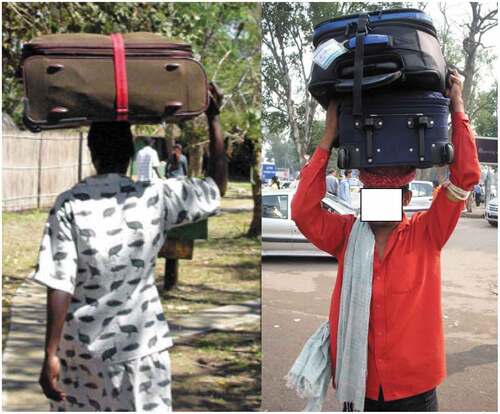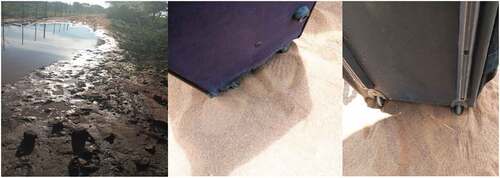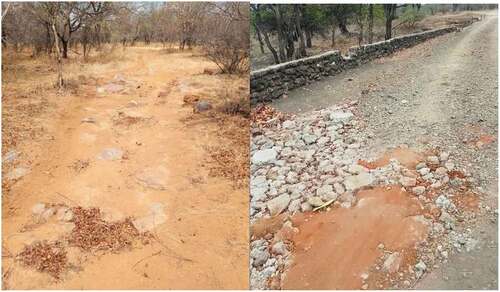Abstract
Material handling aids are of concern to researchers as they seek ways to minimise workload and the risk of injury. Most researchers have focused on industrial carts, while wheeled luggage has received little attention. Some of the previous studies on wheeled luggage have recommended that wheeled luggage be treated as a material handling aid and that researchers study the usability of wheeled luggage more. Four main types of wheeled luggage are identified and these have three modes of movement: pushing, pulling or a combination of both. Pulled wheeled luggage designs have been found to have ergonomic flaws such as too much stress on the pulling arm and awkward postures. Design analysis shows that most existing wheeled luggage is unsuitable for developing countries because of poor ergonomics, instability and low usability on rough or rural terrain. Larger wheels and higher ground clearance can address some of the concerns. Initial findings show that push-trolley luggage addresses most of the main design inadequacies of pulled two-wheel luggage. Studies need to be carried out to determine the potential of push-trolley luggage and design of wheeled luggage for developing countries. Some existing design solutions can be optimised to improve or replace the designs of the most widely used wheeled luggage. Optimised wheeled push-trolley luggage is suggested as a solution to headloading and drudgery in developing countries. An online journal search, journal analysis and rural terrain analysis are conducted. Three wheeled bags were tested on rural terrain in two developing countries and their performance was inadequate.
1. Introduction
Wheeled luggage is considered in this study and in a few other existing studies as a material handling aid. Material handling often employs wide variety of manual, semi-automated and automated equipment and wheeled vehicles. Manual material handling refers to activities such as pushing, pulling, lifting or lowering loads (Rajendran et al., Citation2021). Numerous studies have been carried out to optimise material handling aids in terms of ergonomics and performance, (e.g. Al-Eisawi et al., Citation1999; Boyer et al., Citation2013; Jäger et al., Citation1984; Lawson et al., Citation1994; L-Eisawi et al., Citation1999; Mack et al., Citation1995). In most literature of industrial ergonomics, the term material handling aids refers mostly to two- and four-wheeled carts, trolleys, wheeled containers and wheel barrows. Most material handling aids are either pushed or pulled during use. Ergonomic studies on material handling aids often reveal ergonomic inadequacies in the designs of the aids.
Material handling aids should be designed with ergonomics in mind to reduce workload and risk of musculoskeletal disorders. Manual material handling activities can lead to an increased risk of injuries in the neck and shoulders (Hoozemans et al., Citation2014; Mayer et al., Citation2012; Nimbarte et al., Citation2013). Furthermore, it has also been reported that excessive manual material handling can lead to increased risk of back injuries (Nimbarte et al., Citation2013; Snook et al., Citation1978).
Wheeled luggage is a material handing storage system often used by traveller to store and transport their goods and personal belonging from one point to another. In recent years, there has been an increase in travel worldwide and this will result in an increase in the use of wheeled luggage. According to the United Nation World Tourism Organisation (UNWTO), 2019 was the tenth consecutive year of growth in international tourist arrivals and there was an estimated 1.1 billion international tourist arrivals in the first nine months of 2019, an increase of about 43 million from the same period in 2018 (UNWTO, Citation2020). This has led to an increase in luggage use and luggage sales. According to a research consultancy firm called Statista the global market value of luggage in 2020 was $22.78 billion and is expected to be approximately $25.7 billion in 2024 (Statista, Citation2015). However, there are a limited number of comprehensive studies specifically on wheeled luggage (e.g. Jung, Citation2004; Jung et al., Citation2007; Jun-Seok, Citation2006) and none focusing on developing world terrain.
Most researchers have ignored wheeled luggage and focused on heavy-duty industrial carts (Jun-Seok, Citation2006) despite the widespread use of wheeled luggage and reported injury due to luggage use. Myung et al. (Jung et al., Citation2003) found that two-wheeled pulled luggage has ergonomic shortfalls such as too much stress on the users during operation. As a consequence of the observed shortfalls two of the luggage studies concluded that pulled two-wheeled luggage is poorly designed and used (Jung, Citation2004; Jun-Seok, Citation2006).
In the United States, nearly 54,000 luggage-related injuries occurred in 2012 (AAOOS, Citation2013), while the number of people in who received treatment for luggage-related injuries in US emergency centres rose from 73,000 in 2014 to 84,000 in 2015 (University of Minnesota Physicians and University of Minnesota Medical Center, Citation2016). Usage of heavy luggage has the risk of musculoskeletal disorders (Jung, Citation2004; Pirruccio & Kelly, Citation2020).
Material handling is a very broad topic which cannot be covered in one review paper; hence, this review seeks to re-evaluate studies on wheeled luggage usability, designs and associated problems. Luggage usability refers to the ability of luggage to perform its tasks efficiently, effectively and safely. Recommendations on the design of wheeled luggage will be made based on the cited studies, observations of luggage use and analysis of the existing designs.
2. An overview of modern wheeled luggage
The patent application for the first commercially successful wheeled luggage, a wheeled suitcase was filed by Bernard David Sadow in 1970 (Hunter, Citation2010). Sadow is widely regarded as the inventor of modern commercial wheeled luggage, but he was not the first to fit wheels on luggage since the first patent for a wheeled luggage was filed by Theophilus Hokkanen in 1921 (Hokkanen, Citation1921). Sadow went into luggage business and at one time was an owner and president of a company called US Luggage (Hunter, Citation2010). US Luggage is one of the oldest luggage companies, and today is known as Briggs & Riley. Figure shows two images: (a) a modern Briggs & Riley wheeled suitcase and (b) the initial suitcase design made by US luggage.
Figure 1. (a) A modern Briggs & Riley suitcase and (b) a suitcase by US Luggage (Briggs-Riley, Citation2021).

Sadow’s wheeled suitcase had four castors underneath it and would be pulled via a leather strap on the side of the user. Consequently, the suitcase would relieve the user of the burden of lifting the entire bag. The suitcase lessened the risks due to injury as a result of lifting and significantly reduced the effort required to transport luggage. However, because of the narrow base the suitcase was susceptible to tipping over, wobbly and difficult to use (Hunter, Citation2010).
2.1. Types of wheeled luggage
An analysis of existing luggage designs was carried out and luggage split into different categories depending on the design of the luggage.
2.1.1. Pulled wheeled roller luggage
Pulled wheeled luggage is normally pulled from behind the user by a single arm as shown in Figure . Pulling is the most widely used means of moving wheeled luggage. By balancing the slanted bag on two wheels, the user supports part of the load. Most of the wheels have been observed by authors to range between 5 and 8 cm in diameter. The volumes of commercial wheeled luggage bags were observed to vary greatly ranging from approximately 30 litres to about 170 litres.
Figure 2. A two-wheeled suitcase in motion (Miller, Citation2015).
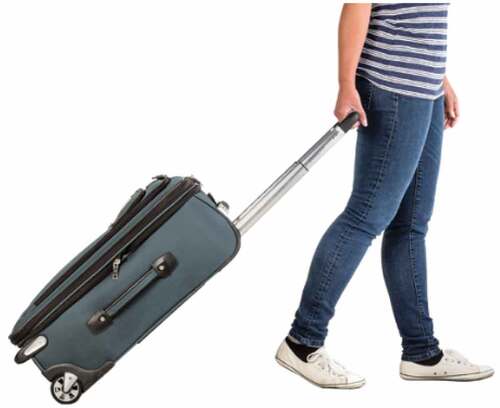
2.1.1.1. Two-wheeled roller suitcases
A major breakthrough in the history of wheeled luggage occurred in 1987 when Robert Plath developed a standing wheeled two-wheeled suitcase with a retractable handle. He was granted the patent in 1991 (Plath, Citation1989). He named it the “Rollaboard” and this suitcase marked the beginning of a luggage company called Travelpro (Goldstein, Citation2019) and quickly overtook Bernard Sadow’s suitcase in terms of popularity (Sharkey, Citation2010).
Two-wheeled suitcases are some of the most common types of luggage. They usually come with a telescopic handle which the user uses to pull. Figure shows a medium-sized two-wheeled pulled suitcase with a retractable handle being pulled along. They tended to be more stable and easier to control than the first suitcase design designed by Bernand Sadow although the transferred some of the weight of the bag to the user’s hand.
2.1.1.2. Two-wheeled duffel bags
Duffel bags are usually close to cylindrical in shape, made of flexible fabric and designed to be carried over the shoulders. Some duffel bags are often fitted with two wheels and can also pulled from behind like in Figure . The main advantages of duffel bags are their generous volume and lightweight flexible construction. The largest duffle bags are among the most voluminous bags one can buy. Figure shows a wheeled duffel bag.
Figure 3. A wheeled duffel bag (Amazon, Citation2022a).
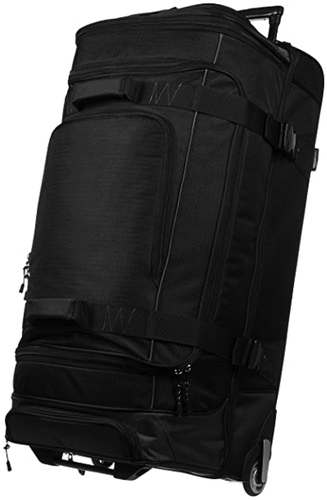
2.1.1.3. Two-wheeled backpacks
Backpacks are bags designed to be carried on the back usually secured onto the user’s shoulders by a pair of straps. The main benefit of having wheels fitted on backpacks is the ability to allow users to pull backpacks, especially when they are too heavy for the back. However, the wheels and associated frames add weight. Figure shows a wheeled backpack.
Figure 4. A two-wheeled backpack (Amazon, Citation2022c).
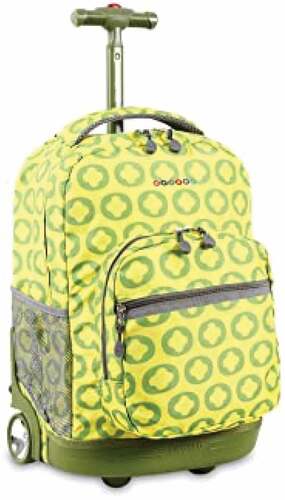
2.2. All-terrain bags
A few manufacturers and luggage designers have created two-wheeled suitcases and duffel bags designed for rough outdoor environments. These bags have been observed to have wheels much larger than the mostly 5–8 cm diameter wheels found on convectional luggage and more ground clearance. Some of the wheels can sometimes be 20–30 cm in diameter, as seen in Figure . One commercially available all-terrain luggage is from the brand called Zuca (Zuca Inc, Citation2021). Another concept called the Gringo all-terrain is, at the time of writing this review, yet to be widely available for commercial sale. The Gringo’s ground clearance can be adjusted to three different heights. The higher ground clearance can result in more instability so the Zuca benefits from having higher ground clearance only when its needed. Figure shows the Zuca (a) and a Gringo all-terrain bags (b) and they have 30 and 20 cm diameter wheels, respectively. The large wheels and higher ground clearance enable use over rough terrain such as mud, rocky surfaces and sand.
Figure 5. The Zuca and Gringo all-terrain bags (Gringo-the revolutionary all terrain travel bag, Citation2018; Zuca Inc, Citation2021).
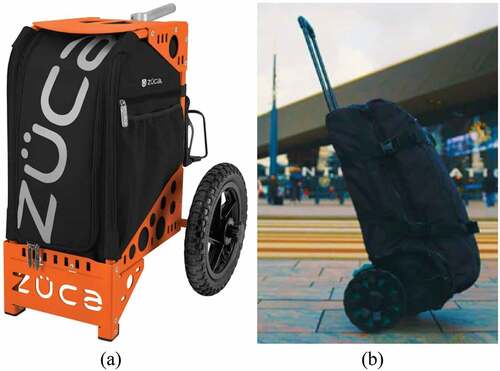
2.3. Spinner wheeled suitcases
In 2004, Samsonite released the world’s first four-wheeled spinner suitcase they named Sahora (Braggs, Citation2018; Husband, Citation2017). This spinner suitcase design quickly became popular and common among travellers. Spinner suitcases are normally fitted with four castors (spinners) wheels at bottom which allow the suitcase to be pushed and pulled upright in any direction. The wheels can spin 360°. A clear advantage is that the whole weight of the suitcases can rest on the wheels while they are being moved. However, the suitcases are usually pushed on good surfaces and then pulled on two wheels on rougher outdoor surfaces. They tend to be unstable on uneven terrain and often the wheels are so small that they get caught in cracks or bumps making spinner suitcases unsuitable for unpaved roads. The wheels on spinner suitcases tend to be smaller than those on two-wheeled suitcases making them more susceptible to damage and higher rates of wear. Figure shows a spinner suitcase.
Figure 6. A Samsonite spinner suitcase (Amazon, Citation2022b).
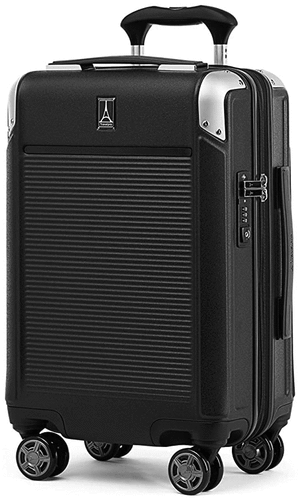
2.4. Push-trolley luggage
A new segment of wheeled luggage has emerged recently and in this study we refer to it as the push-trolley luggage segment. The push-trolley suitcases are designed specifically to be pushed in front of the user, mostly on four wheels. Push-trolley luggage is pushed in the similar manner shopping trolleys are pushed. The major advantage of this design over pulled luggage is that there is no weight load place on the user. Most push-trolley suitcases have one set of wheels (rear or front) swivelling to give the suitcase direction. Figure shows some of the push-trolley suitcases available for purchase. Despite the evident ergonomic advantages offered by push-trolley suitcases compared to pulled luggage they remain a niche segment in the luggage market making up an insignificant share of large sales.
Figure shows the push-trolley suitcase called the Boxer made by a company called Bugaboo. However, its high price means it will remain a niche product and unattainable to a significant portion of luggage users. Like the Boxer, most push-trolley suitcases have the ability to transport other suitable suitcases, as seen in Figure . The Bag Rider is also designed to carry a small child, as seen in Figure .
Figure 7. The GR-O SIX concept (left picture) and Bag Rider (MountainBuggy, Citation2021) push-trolley suitcases.

Figure 8. The Boxer push -trolley suitcase (Bugaboo, Citation2019).
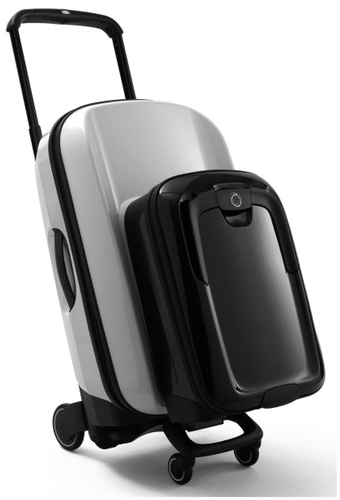
2.5. Smart luggage
According to one research consultant, “The term ‘smart luggage’ is widely used for bags and suitcases with various tech-savvy features such as Wi-Fi hotspots, SIM cards, GPS, Bluetooth, RFID, built-in batteries, and digital scaling” (Zeng et al., Citation2022). Some smart bags have been motorised to enable independent movement and, in a few cases, they can transport the user as well. Smart luggage generally tends to be much more expensive than other types of luggage and the added devices can increase the weight of the bag significantly. Figure shows one such smart suitcase with a built-in battery for charging electronic gadgets.
Figure 9. A smart suitcase with charging capability (Insider Inc, Citation2022).
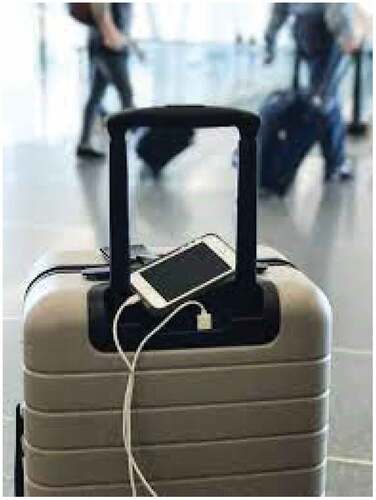
3. A summary of existing luggage usability studies
Wheeled luggage usability refers to the ability of the luggage to perform its tasks efficiently, effectively and safely. This performance may refer to load bearing, manoeuvrability, durability, ergonomics and fitness for purpose or user satisfaction. In this section, we seek to compile and analyse studies that address luggage usability.
3.1. Search criteria
An online journal search was conducted to find relevant studies on wheeled luggage. A criterion was set for searching for relevant journal papers. Each paper was assessed for originality, impact factor and essential quality measures. Searches for relevant terms namely “luggage design or luggage optimisation ”, “wheeled luggage” or “wheeled bags” or “wheeled suitcases”, “luggage ergonomics”, “luggage usability”, “luggage injuries” or “luggage musculoskeletal disorders”, “baggage” and “ergonomics”,and “baggage handling” and “ergonomics” were made across Scopus and Web of Science databases with the quoted Boolean operators as shown in Table .
Table 1. Searches and number of papers retained at each stage using
The search results were filtered using the following filters: (1) Luggage that is wheeled (2) The use of manual pulling and pushing as the main means of handling luggage. No publication date restrictions were employed.
Studies were included if any of the following factors that affect wheeled luggage usability were investigated by the source:
Wheel sizing and rotation
User posture
Handle height, size and position
Exertion forces and kinesiology
Luggage weight and dimensions
User task experience and user surveys
Musculoskeletal disorders (MSDs) and injuries
Terrain performance
Since luggage can either be wheeled or not have any wheels, it is important to make that distinction when searching for journals. The terms “baggage” and “luggage” can be interchanged; however, the term “luggage” is more widely used by authors therefore is more preferable.
The search was widened to include search engine results on thesis documents using the stipulated criteria.
3.2. Results
When two-wheeled luggage is pulled fast enough it may become unstable and undergo undamped rocking oscillations that may overturn it. A few studies (Facchini et al., Citation2017; Plaut, Citation1996; Suherman et al., Citation1997) studied the rocking stability of two-wheeled luggage.
Studies that are titled with or refer to the term “baggage handling” often refer to the manual or automated handling and storage of luggage (wheeled and not) in transport systems involving trains and aeroplanes (e.g. Brice et al., Citation2015; Garner & Brandes, Citation2000; Lo et al., Citation2021; Malandri et al., Citation2018; Rüger, Citation2018; Zeng et al., Citation2022). However, these studies do not look into the usability or ergonomics of wheeled luggage and, therefore, do not satisfy the criteria set for the review. Some studies (e.g. Davis & Braaksma, Citation1988; Deng et al., Citation2022; Huang et al., Citation2019; Shi et al., Citation2020) have analysed how luggage-laden pedestrians impact the flow of traffic at traffic terminals or specific scenarios. A few of the findings in these studies might be interesting to a researcher studying luggage usability, but in this study, the studies failed to satisfy the criteria and were excluded.
Clearly, most studies on material handling aids focus on industrial carts. Two-wheeled luggage is considered light work therefore has not attracted much research. The operational dynamics of two-wheeled luggage is different to that of four-wheeled carts and deserves more research effort because the movement of two-wheeled luggage employs one hand instead of the two employed in four-wheeled carts (Jun-Seok, Citation2006). Table summarised some of the key research works done so far on wheeled suitcases.
Table 2. A summary of luggage studies
3.3. Injuries and forces associated with materials handling (Wheeled luggage)
Pirrucio and Kelly (Citation2020) analysed the 2003–2017 records of the National Electronic Injury Surveillance System (NEISS) and compiles data on shoulder injuries reported to US emergency departments as a result of luggage use. They found that, on average, 1811 luggage-induced injuries (at a 95% confidence interval of 1123–2499) were reported to US emergency departments. They also found out that 70% of the shoulder injuries were caused by lifting luggage. Women were shown to be more susceptible to shoulder injuries accounting for an average of 62.3% of the injured.
This study focuses only on shoulder injuries and does not report on any other type of injuries affecting other parts of the body. There is no information regarding the extent to which shoulder injuries constitute the total reported luggage-related injuries. There is no information regarding the injuries that are not reported to emergency rooms or those injuries that may be labelled as minor. It is likely that most of the injuries are not reported by luggage users and they are left to heal naturally. It is also possible that a significant number of shoulder injuries are not accounted for since travellers may report injuries to private health-care practitioners that may not keep a record of such incidences. Such information may give a better understanding of the ergonomic shortfalls of luggage. The study does not differentiate between wheeled and non-wheeled luggage. The suggestions given seem to cater mostly for air travel. The usefulness of the findings of the study is also limited by the fact that the study is based solely on US luggage users.
Jung (Citation2004) compiled a thesis based on his study on the ergonomics of pulling two-wheeled suitcases. He conducted luggage pulling tests using four male subjects and measured stress and other biological factors. He proposed that the handle length be set at 110 cm as the average luggage handle length of 100 cm was less ergonomic than the 110 cm length. The 110 cm length resulted in less wrist joint and pulling forces in the side directions. Luggage with an angled pole resulted in 12% less downward force at the handle. Two different wheel diameters were employed: 8 and 15 cm. In his study larger wheels were observed to require 31% less downward force, 14% pulling force, 24% more sideward force and 6% less energy expenditure. Two luggage loads of 15 and 23 kg were tested. The right pulling arm was found to be the most affected by the load. The heavier load resulted in an increase in downward forces and forward pulling forces at the handle of 30% and 39% respectively leading to an increase of 8% in energy expenditure. A higher centre of gravity resulted in the increase of the downward force component by 44% and increase of the forward pulling force by about 184%. Luggage tests were conducted on carpeted surfaces and flat non-carpeted surfaces. Carpeting resulted in an increase in pulling force of 9%. Subject height was found to affect independent variables.
The study made significant findings; however, the experiments were only carried out on indoor surfaces and only one type of wheeled luggage was considered. In real life, luggage is pulled over kerbs, bad potholed surfaces, and sand or muddy surfaces, etc. and this terrain may impose much larger forces and effort on luggage users.
Jun-Seok (Citation2006) made several recommendations in his 2006 thesis study on the usability of two-wheeled luggage. He used mechanical models and usability tests carried out on two prototypes to assess the design of two-wheeled luggage. Pulling force estimation was done using three mechanical models and the minimum pulling force was found at the tilted angle of 65.56° in the sustained phase. The tilted angles of luggage, the distance between the centre of mass and the bottom of luggage, and weight of luggage significantly affected the pulling force.
Luggage pulling experiments involving 8 subjects were carried out on a predetermined path. Usability was assessed from questionnaires availed to the subjects. He found that pole length significantly affects the back, wrist and arm, and that for pole lengths above 125.73 cm, there was an increase in complaint scores on all body parts. The arm caused the most complaints amongst all the body parts during trials of two-wheeled luggage use. He also observed that for luggage pole lengths below 97.79 cm and above 133.35 cm, the pulling force increased. Shorter subjects were said to feel higher pulling forces than taller subjects. Load weight and subjects’ knee knuckle height were found to affect the risk of tripping during the pulling of luggage.
The study only considered the two-wheel luggage type; however, significant findings were made. The pulling force was shown to be most affected by the following factors: load, centre of mass and tilted angle. The study’s findings can give a guide as to how luggage can be designed for users with varying physical attributes. However, some important factors such as wheel size, wheel surface and wheel maintenance were not considered in this study.
Rose et al. (Citation2013) measured spine loading during experiments which employed six different methods of carrying loads. The methods of carrying loads were backpack, bin with handles, bin supported underneath, briefcase, cross shoulder and straight shoulder.
The carrying of loads via a two-wheeled suitcase resulted in one of the lowest anterior/posterior (A/P) shear forces of 389.6 N with standard deviation (SD) of 131.3 N for the 11.3 kg load carrying walking task or experiment. Only the backpack method of the 11.3 kg walking task produced a lower force. Figure shows the experiment subject employing two of the methods of carrying while electromyography (EMG) measurements are being carried out on his spine.
Figure 10. Suitcase and bin with handle method (taken from RoseRose et al., Citation2013).

The study gives insight into how the lower back is loaded when users are pulling two-wheeled luggage. The level of loading of the suitcase did not produce significant changes in the A/P shear forces of the back. However, the suitcase study was very limited in its scope. It was carried out in laboratory setting on perfect indoor terrain, and the wheel size was not specified or investigated.
Jung et al. (Citation2003) studied two types of carry-on luggage focusing on the differences of handles (single curved pole versus double pole) under varying conditions of load weights, subject posture and walking speeds. Two commercial carry-on luggage prototypes were tested by subjects walking on treadmills, one with a slightly curved single pole handle and the other with two straight poles aligned in parallel. Subjects were fitted with markers, videos of them of luggage pulling tasks recorded and analysed using specified software. He found that single, curved and longer poles may benefit the luggage user by creating greater clearance between the luggage and the user’s body. The larger load caused the trunk to slightly flex more than the lighter load. The walking speed was seen to affect the motions of the lower and upper extremities.
The paper made significant findings on the effect of the load size, walking speeds, pole length and size on luggage users. Luggage handles were found to be a significant design factor that luggage designers and manufacturers should consider.
4. Discussion—recommendations on wheeled luggage design
From the foregoing discussion, at least five main luggage handling perspectives (discussed in detail in the next subsections) are apparent.
4.1. Luggage ergonomics
It is widely accepted that the fitment of wheels and handles on luggage has made the manual transportation of luggage easier; however, the pulling of luggage has been observed to cause uncomfortable or awkward postures resulting from an overextended and asymmetric arm, a twisted trunk (Jung, Citation2004), and asymmetric loading of the user. A single arm often has to support approximately half of the weight load of the luggage and also supply the pulling force required to move the bag. In addition to the aforementioned loads, the single arm will also be responsible for steering and balancing the bag in the event of disturbances resulting in additional stress and strain. This posture makes pulling luggage more likely to cause injury to the arm and the wrist than when both hands are employed as in the case of trolleys and pushed wheeled luggage. Luggage users have been known to complain of such injuries resulting from the overloading of a single arm. The effect of this posture needs to be studied further.
The load on the pulling arm will result in fatigue on arms and shoulders relatively quickly. Therefore, pulling luggage is likely an inefficient method of moving luggage over long walking distances such as those prevalent in the developing world. Numerous luggage users or travellers have been observed to regularly switch pulling arms or take rest stops when pulling heavy luggage as a result of the fatigue in the arms and shoulders. In an ergonomic study on two-wheeled luggage, Jung (Citation2004) highlights the need for wheeled luggage to be redesigned in order to reduce the physical load on users.
4.2. The potential of push-trolley luggage
Push-trolley luggage is rare in most luggage markets; however, initial observations show that it seems to address most if not all the above-mentioned pitfalls of pulled two-wheeled luggage. Pushing of push-trolley luggage can easily be done with both hands in front of the user. Since push-trolley bags often have four wheels, the entire weight of push-trolley luggage can be completely supported by the wheels unlike pulled luggage which burdens the user’s arm with some of the weight. When push-trolley luggage is being used, the trunk is not twisted and the arms are evenly loaded in a seemingly more symmetrical position than in the case of pulled luggage where one arm is hyper-extended under a much larger load. Push-trolley luggage is likely to cause much less stress, fatigue and uncomfortable postures leading to less musculoskeletal injuries and increased carrying capacity. Another advantage of the push-trolley luggage is that the luggage is almost always in front of the user making it easier to control the bag and possibly lessening the risk of tripping and falling. Research on push-trolley luggage to measure the suggested benefits above is needed; however, no studies on this particular type of luggage could be found.
4.3. Rural terrain and the developing world
It is widely recognized that most available wheeled luggage is primarily meant to be used on good, hard, dry and even surfaces (mostly paved roads or indoors). In developing countries many roads and walk paths, especially in the rural areas, are covered in uneven surfaces that consist of sand, mud, gravel, shallow streams, puddles, stones, sticks or vegetation such as grass. These terrain types are collectively referred to as rural terrain in this review. One measure of the accessibility of rural areas is the Rural Access Index (RAI) which is defined by Roberts and Rastogi (Citation2006) as “the number of rural people who live within two kilometres (typically equivalent to a walk of 20–25 minutes) of an all-season road as a proportion of the total rural population”. It has been ascertained that while most European countries have an RAI close to 100%, most developing countries are below 60%, all sub-Saharan countries are below 51%, and 24 countries are below 20% (Mikou et al., Citation2019). According to World Bank data 59% of the African population resides in rural areas (World Bank, Citation2021). Travel in some rural areas is documented to consist of long walking distances sometimes ranging from 4 km to as much as 20 km per trip because of transport and financial constraints. Such long walking distances are likely to be unsuitable for most existing wheeled luggage available to the developing world.
Most leading luggage manufacturers and designers seem to be overly concerned about the usability of luggage for air travel, while air travel is relatively rare in developing countries. This has resulted in design choices such as miniscule, delicate light wheels that are not suited to conditions in the developing world.
4.3.1. A case for larger wheels
Wheeled luggage wheel diameter often varies from about 5–8 cm. Jung (Citation2004) found typical wheel diameter for carry-on luggage to be about 8 cm. Compared with larger wheels smaller wheels are more prone to getting stuck on poor surfaces or are easily obstructed by holes, humps, cracks and other obstructions (Konz & Johnson, Citation2004). No studies of the usability of wheeled luggage on outdoor terrain and terrain prevalent in developing world could be found. No comparisons of luggage wheel diameters could be found. Numerous studies on industrial carts have found that larger wheels or castors lower cart pushing or pulling forces significantly (Al-Eisawi et al., Citation1999; David & Nicholson, Citation1982; Drury et al., Citation1975; Jung, Citation2004). This is a result of larger wheels having lower rolling friction and needing less force to push over kerbs, stones and steps. Larger wheels will not only lower exertion forces but permit wheeled luggage to be used on rough rural terrain as well. Given the known ergonomic benefits of larger wheels, it is necessary to study the effect of bigger wheels on wheeled luggage, especially the luggage that is to be used in developing countries. Larger wheels will likely wear out slower and be less prone to breaking as well.
The developing world could also benefit from all-terrain wheeled luggage such as the type shown in ; however, most luggage manufacturers have not produced such type of luggage. The larger wheels, larger ground clearance and tougher built of all-terrain luggage could make it far more usable for the rural terrain prevalent in developing countries.
4.3.2. Head loading of wheeled luggage
A common sight in the developing world is travellers carrying wheeled luggage on their heads or lifted without making use of the wheels as shown in Figure . Most of the travellers seem to find wheeled luggage unusable on most outdoor terrain. No survey on the usability of wheeled luggage in the developing world could be found. This study could only find one commercially available wheeled luggage product called the Zuca (see Figure ) designed to handle rural terrain, but it seems to be mostly too sophisticated, unaffordable, and unavailable in developing countries, and has limited storage capacity.
The practice of transporting goods supported on the head (headloading) over long walking distances is common across developing nations. This has been observed to impact the health of women in sub-Saharan Africa negatively resulting in deformation of the spine, backache, miscarriages, osteoarthritis, etc. (Carr, Citation1983; Doran, Citation1996; Mudzamba, Citation1998). Solutions have been sought to address the problem of headloading in developing nations and Intermediate Means of Transport (IMTs) have been proposed as a solution. Appropriately designed wheeled luggage is widely ignored as a possible solution.
4.3.3. Wheeled luggage as an Intermediate Means of Transport
Reports from the World Bank, UN and literature on transport challenges in the developing world often refer to the term Intermediate Means of Transport (IMT). IMTs can be described as “local transport solutions that increase transport capacity and reduce drudgery at a relatively low capital cost” (Starkey, Citation2001). They are termed intermediate because they cover the gap between walking, headloading and large-scale mass transport in addition to them being equipment at the intermediate stage in the technological evolution (Starkey, Citation2001). IMT often refers to devices such as hand carts, wheelbarrows, animal drawn carts, bicycles, tricycles and motor cycles.
Cheap IMT solutions have been sought to assist people in the developing world who have to walk long distances carrying heavy loads (Porter, Citation2008; SSATP, Citation2003). Appropriately designed wheeled luggage has not been considered as a possible IMT solution; however, it could play a role as an IMT considering that it could be made affordable for low-income earners in developing countries.
4.3.4. Testing available wheeled luggage on rural terrain
A brief analysis was carried out on the performance of common wheeled luggage on rural terrain. A wheeled suitcase, four-wheeled spinner suitcase and wheeled duffel bag were pulled on a rural road or path in Botswana while loaded with a weight of 12.5 kg. The bags have wheels of 44–55 mm diameter and widths of 19, 18 and 22 mm, respectively. The ground clearance of the bags were 20, 61, and 24 mm, respectively. The road (Figure ) is used by mostly pedestrians, donkey carts and light vehicles. Figure also shows two bags on the road.
As expected, the three wheeled bags were completely unusable on the road. The ground clearance was inadequate, so the bags’ under-bodies rubbed against the sand. The wheel wells of the two-wheeled bags were completely submerged in sand rendering the wheels useless. Stones on some sections of the road impeded the movement of the wheels. Any attempt to force movement would have resulted in damage to the bags or wheels. Spinner suitcase could not be pushed with its four castors but could only be pulled on two castors.
Even on some paved surfaces in a local shopping district, the bags were difficult to use especially on old pavements which are uneven and damaged. The wheels were too small to negotiate some edges and surfaces and the under-body scratched the surface frequently. The contact surface of the wheels on the duffle bag cracked and chipped away on impact with hard surfaces
The exercise demonstrated the modern luggage is unsuitable for use in the rural terrain prevalent in the developing world.
4.3.5. Terrain analysis
In order to determine the design criteria that would reasonably satisfy the needs of wheeled luggage users on rural terrain, five footpaths and gravel or unpaved road sections measuring 1 km each were analysed. The foot paths and roads were selected in rural areas (villages) in Botswana and Zimbabwe during the dry and rainy seasons. The raw data on the paths and roads was gathered using the Terrain Data Forms in Appendix A and B.
Figure shows a path on Path C (see Appendix A) that cuts through forests that are often used by villagers when travelling by foot. In this case, the path is mostly solid ground with little lose sand but can be littered with cow dung, twigs, embedded and loose stones, etc. Figure also shows Path D which connects a main road to rural school in Zimbabwe.
The data will be used to guide the specification of design criteria such as wheel size and design, ground clearance, material selection, ergonomics considerations, etc. in future studies.
5. Conclusion
There is tremendous potential to improve the usability of wheeled luggage. Four-wheeled push-trolley luggage seems to have numerous advantages over two-wheeled luggage and could address most of the concerns about pulled two-wheeled luggage. A thorough understanding of the advantages and disadvantages of push-trolley luggage is needed. No studies specifically on four-wheeled luggage could be found in this review.
In general, available modern wheeled luggage does not sufficiently meet the needs of users in the developing world. There is a need for wheeled luggage that is usable in the developing countries where much of the terrain and long walking distances are unsuitable for almost all of the commercially available wheeled luggage.
Larger wheels on wheeled luggage should be explored as larger wheels lower exertion forces, enable the luggage to traverse rural terrain and will likely reduce the risk of wheel breakage and wear. Design analysis and experience reveals that most wheels fitted on most luggage are largely fragile and prone to breakage and high wear, especially with heavy usage.
Scientific studies should be carried out to determine the usability of wheeled luggage in the developing world and come up with design criteria and new luggage concepts to improve usability of wheeled luggage on rural terrain.
The review proposes that wheeled luggage be considered as a possible IMT solution and that new appropriate luggage design concepts be created and studied. Appropriate wheeled luggage designs could address some of the challenges of transporting goods in developing world such as headloading and drudgery.
A very limited number studies on wheeled luggage could be found. There is a need for further research to attempt to expand on the findings of the aforementioned studies and, if possible, offer solutions to the identified problems.
6. Future work
The authors intend to carry out scientific studies on the usability of wheeled luggage especially in the developing world and come up with versatile and innovative concept designs that will address some the flaws of existing luggage and possibly play the role of an IMT solution. The authors will explore the scientific relationship between luggage wheel size and usability on rural terrain, ergonomics and other factors required to make wheeled luggage more practical in the developing world.
Disclosure statement
No potential conflict of interest was reported by the author(s).
Additional information
Funding
References
- AAOOS. “Enjoy the holidays free from luggage-related injuries,” American Academy of Orthopaedic Surgeons, 2013. [Online]. Available: http://newsroom.aaos.org/media-resources/news/enjoy-the-holidays-free-from-luggage-related-injuries.htm. [Accessed: 05-Mar-2015]
- Al-Eisawi, K. W., Kerk, C. J., Congleton, J. J., Amendola, A. A., Jenkins, O. C., & Gaines, W. G. (1999). The effect of handle height and cart load on the initial hand forces in cart pushing and pulling. Ergonomics, 42(8), 1099–21. https://doi.org/10.1080/001401399185162
- Amazon. “J World New York Sunrise Rolling Backpack. Roller Bag with Wheels, Lime Logo, 18”,” 2022. [Online]. Available: https://www.amazon.com/World-New-York-Everyday-Backpack/dp/B00K78JTXO/ref=sr_1_13?keywords=backpack+with+wheels&qid=1649180320&sr=8-13. [Accessed: 05-Apr-2022c]
- Amazon. “Travel duffel bags,” Amazon Website, 2022a. [Online]. Available: https://www.amazon.com/travel-duffels/b?ie=UTF8&node=15743211 [Accessed: 05-Apr-2022] 2022a
- Amazon. “Travelpro Platinum Elite Hardside Expandable Spinner Wheel Luggage TSA Lock Hard Shell Polycarbonate Suitcase, Shadow Black, Compact Carry-On 20-Inch,” Amazon Website, 2022b. [Online]. Available: https://www.amazon.com/Travelpro-Platinum-Expandable-Hardside-Spinner/dp/B0937NC229/ref=sr_1_3_sspa?c=ts&keywords=Luggage&qid=1649185163&refinements=p_89%3ASamsonite&s=apparel&sr=1-3-spons&ts_id=15743251&spLa=ZW5jcnlwdGVkUXVhbGlmaWVyPUEyRFhWWVdISlVXT0pZJmVuY3J5cHRlZElkPUEwMzAzMjQ2MUk5RVFHMTJNM0JOMiZlbmNyeXB0ZWRBZElkPUEwMTE0NzAxMTVGWEtSVzY0WlVFRSZ3aWRnZXROYW1lPXNwX2F0ZiZhY3Rpb249Y2xpY2tSZWRpcmVjdCZkb05vdExvZ0NsaWNrPXRydWU&th=1. [Accessed: 05-Apr-2022]
- Boyer, J., Lin, J., & Chang, C. (2013). Description and analysis of hand forces in medicine cart pushing tasks. Applied Ergonomics, 44(1), 48–57. https://doi.org/10.1016/j.apergo.2012.04.008
- Braggs, S. “The first suitcases with wheels,” Retrowow, 2018. [Online]. Available: https://www.retrowow.co.uk/retro_collectibles/luggage/suitcases_with_wheels.php. [Accessed: 12-May-2021]
- Brice, D., Marinov, M., & Rüger, B. (2015). A newly designed baggage transfer system implemented using event-based simulations. Urban Rail Transit, 1(4), 194–214. https://doi.org/10.1007/s40864-015-0027-4
- Briggs-Riley. “Our story-history,” 2021. Available: https://www.briggs-riley.com/pages/our-story. [Accessed: 12 May 2021]
- Bugaboo. “Boxer luggage system,” Bugaboo, 2019. [Online]. Available: https://www.bugaboo.com/. [ Accessed: 23-May-2021]
- Carr, M. (1983). The long walk home. Abbreviation of Technology, 10(1), 17–19.
- David, G. C., & Nicholson, A. S. Aids to lifting and handling. 3rd Int. Environ. & Safety Conf. 1-3 Sep 1982. (1982). Vol. 1982
- Davis, D. G., & Braaksma, J. P. (1988). Adjusting for luggage-laden pedestrians in airport terminals. Transportation Research Part A: General, 22(5), 375–388. https://doi.org/10.1016/0191-2607(88)90014-3
- Deng, Q., Fu, Z., Li, T., Ma, J., & Luo, L. (2022). Effect of luggage-carrying on pedestrian flow through bottleneck: An experimental study. Transportmetrica A: Transport Science
- Doran. (1996). Intermediate Technology Publications, UNIFEM. 1853393452. worldcat.org/ISBN/1853393452
- Drury, C. G., Barnes, R. E., & Daniels, E. B. “Pedestrian operated vehicles in hospitals,” in 26th spring annual conference and world productivity congress, 1975, pp. 184–191.
- Facchini, G., Sekimoto, K., & du Pont, S. C. (2017, June). The rolling suitcase instability: A coupling between translation and rotation. Proceedings of the Royal Society A: Mathematical, Physical and Engineering Sciences, 473(2202).
- Garner, M., & Brandes, K. (2000). Defining airline compatible luggage. Journal of Air Transport Management, 6(4), 239–244. https://doi.org/10.1016/S0969-6997(00)00017-X
- Goldstein, M. “The triumph of the roller bag,” Forbes Magazine, April 15 2019. forbes.com/sites/michaelgoldstein/2019/04/15/the-triumph-of-the-roller-bag/?sh=184b8ebcaa7e
- Gringo-the revolutionary all terrain travel bag.” Kickstarter, 2018. [Online]. Available: http://kickstarter.com/projects/gringotravelbags/gringo-the-revolutionary-all-terrain-travel-bag. [Accessed: 03-Apr-2021]
- Hokkanen, T. (1921). A45C5/143 - Rigid or semi-rigid luggage with built-in rolling means detachable. US1413852A. patents.google.com/patent/US1413852A/en
- Hoozemans, M. J. M., Knelange, E. B., Frings-Dresen, M. H. W., Veeger, H. E. J., & Kuijer, P. P. F. M. (2014, November). Are pushing and pulling work-related risk factors for upper extremity symptoms? A systematic review of observational studies. Occupational and Environmental Medicine, 71(11), 788–795. https://doi.org/10.1136/oemed-2013-101837
- Huang, S., Wei, R., Lo, S., Lu, S., Li, C., An, C., & Liu, X. (2019). Experimental study on one-dimensional movement of luggage-laden pedestrian. Physica A: Statistical Mechanics and Its Applications, 516, 520–528. https://doi.org/10.1016/j.physa.2018.09.038
- Hunter, arnie. CNN 13 April 2022. edition.cnn.com/2010/TRAVEL/10/04/wheeled.luggage.annivesary/index.html. . (2010 Happy Anivesary. Wheeled Luggage!)
- Husband, S. (2017). The History of Samsonite. Luxembourg.
- Insider Inc. “This modern, stylish suitcase is guaranteed for life — Plus, it charges your phone,” Business Insider, 2022. [Online]. Available: https://www.businessinsider.com/away-suitcase-with-phone-charger-photos-2017-1. [Accessed: 06-Apr-2022]
- Jäger, M., Luttmann, A., & Laurig, W. (1984). The load on the spine during the transport of dustbins. Applied Ergonomics, 15(2), 91–98. https://doi.org/10.1016/0003-6870(84)90278-3
- Jung, M.-C. (2004). Ergonomic assessment of a wheeled luggage pulling task. Pennsylvania State University.
- Jung, M.-C., Haight, J. M., & Freivalds, A. (2003). Kinematic Evaluation of Pulling Carry-on Luggage. Proceedings of the Human Factors and Ergonomics Society Annual Meeting, 47(10), 1290–1294. https://doi.org/10.1177/154193120304701041
- Jung, M.-C., Haight, J., & Susan, M. H. (2007). Biomechanical and physiological analyses of a luggage-pulling task. Industrial Health, 45(6), 756–765. https://doi.org/10.2486/indhealth.45.756
- Jun-Seok, L. (2006). Design assessment of two-wheeled luggage based on mechanical models and a usability test. https//trace.tennessee.edu/edu/cgi.viewcontent.cgi?article=3241&content=_graddiss
- Konz, S., & Johnson, S. (2004). Work design: industrial ergonomics (6th) ed.). Holcomb Hathaway.
- Lawson, J., Potiki, J., & Watson, H. (1994). Ergonomics guidelines for manually-handled trolleys in the health industry. Central Sydney Health Service.
- L-Eisawi, K. W., Ker, C. J., Congleton, J. J., Amendola, A. A., Jenkins, O. C., & Gaines, D. (1999). Factors affecting minimum push and pull forces of manual carts. Applied Ergonomics, 30(3), 235–245. https://doi.org/10.1016/S0003-6870(98)00019-2
- Lo, L. P., Marinov, M., & Rüger, B. (2021). A qualitative study on providing alternative solutions for handling the hsr passenger’s luggage. Urban Rail Transit, 7(1), 12–28. https://doi.org/10.1007/s40864-020-00139-y
- Mack, K., Haslegrave, C., & Gray, M. (1995). Usability of manual handling aids for transporting materials. Applied Ergonomics, 26(5), 353–364. https://doi.org/10.1016/0003-6870(95)00056-9
- Malandri, C., Briccoli, M., Mantecchini, L., & Paganelli, F. (2018). A discrete event simulation model for inbound baggage handling. Transportation Research Procedia, 35, 295–304. https://doi.org/10.1016/j.trpro.2018.12.008
- Mayer, J., Kraus, T., & Ochsmann, E. (2012, August). Longitudinal evidence for the association between work-related physical exposures and neck and/or shoulder complaints: A systematic review. International Archives of Occupational and Environmental Health, 85(6), 587–603. https://doi.org/10.1007/s00420-011-0701-0
- Mikou, M., Rozenberg, J., Koks, E., Fox, C., & Quiros, T. P. (2019). Assessing rural accessibility and rural roads investment needs using open source data.
- Miller, K. “Pull your suitcase (or Cello case) Better,” violinist.com, 2015. [Online]. Available: https://www.violinist.com/blog/MusiciansHealthCollective/20151/16498/. [Accessed: 10-Jul-2021]
- MountainBuggy. “bagriderTM | Riders | mountain buggy®,” MountainBuggy Company, 2021. [Online]. Available: https://us.mountainbuggy.com/products/bagrider. [Accessed: 17-Jun-2021]
- Mudzamba, E. (1998). The transport burden on women and girls in Zimbabwe’s rural areas. 22/04/2021.
- Nimbarte, A. D., Sun, Y., Jaridi, M., & Hsiao, H. (2013). Biomechanical loading of the shoulder complex and lumbosacral joints during dynamic cart pushing task. Applied Ergonomics, 44(5), 841–849. https://doi.org/10.1016/j.apergo.2013.02.008
- Pirruccio, K., & Kelly, J. D. (2020). Shoulder injuries associated with handling luggage presenting to U.S. emergency departments: 2003-2017. Work, 66(3), 603–609. https://doi.org/10.3233/WOR-203202
- Plath, R. (1989). Wheeled suitcase and luggage support. US4995487A. patents.google.com/patent/US4995487A
- Plaut, R. H. (1996). Rocking instability of a pulled suitcase with two wheels. Acta Mechanica, 117(1–4), 165–179. https://doi.org/10.1007/BF01181045
- Porter, G. (2008). Transport planning in sub-Saharan Africa. Durham.
- Rajendran, M., Sajeev, A., Shanmugavel, R., & Rajpradeesh, T. (2021). Ergonomic evaluation of workers during manual material handling. Materials Today: Proceedings, 46, 7770–7776. https://doi.org/10.1016/j.matpr.2021.02.283
- Roberts, P., & Rastogi, C. (2006). Rural access index: a key development indicator. The World Bank.
- Rose, J. D., Mendel, E., & Marras, W. S. (2013). Carrying and spine loading. Ergonomics, 56(11), 1722–1732. https://doi.org/10.1080/00140139.2013.835870
- Rüger, B. (2018). Baggage Handling. Sustainable Rail Transport, 93–112.
- Sharkey, J. “Reinventing the Suitcase by Adding the Wheel,” New York Times, New York, 4 October2010. nytimes.com/2010/10/05/business/05road.html
- Shi, Z., Zhang, J., Ren, X., & Song, W. (2020, October). Quantifying the impact of luggage on pedestrian walking and running movements. Safety Science, 130. https://doi.org/10.1016/j.ssci.2020.104856.
- Snook, S. H., Campanelli, R. A., & Hart, J. W. (1978, July). A study of three preventive approaches to low back injury. Journal of Occupational and Environmental Medicine, 20(7), 478–481.
- SSATP. “Promoting intermediate means of transport,” 2003. SSATP Working Paper No 20.
- Starkey, P., World Bank. (2001). Local transport solutions: People, paradoxes and progress. 56. World Bank, SSATP Africa Regions. Statista.
- Statista. “Retail sales value of the global luggage market from 2006 to 2015, by segment (in million U.S. dollars),” Statista, 2015. [Online]. Available: http://www.statista.com/statistics/252856/retail-sales-value-of-the-global-luggage-market-by-segment/. [Accessed: 14-Mar-2020]
- Suherman, S., Plaut, R. H., Watson, L. T., & Thompson, S. (1997, November). Effect of human response time on rocking instability of a two-wheeled suitcase. Journal of Sound and Vibration, 207(5), 617–625. https://doi.org/10.1006/jsvi.1997.1141
- University of Minnesota Physicians and University of Minnesota Medical Center. “HOW TO AVOID LUGGAGE-RELATED INJURIES THIS HOLIDAY TRAVEL SEASON,” Mhealth, 2016. [Online]. Available: https://www.mhealth.org/blog/2016/december-2016/how-to-avoid-luggage-related-injuries-this-holiday-travel-season. [Accessed: 21-Jun-2021]
- UNWTO. (2020). World Tourism Barometer. UNWTO. 4 July 2022. http://documents1.worldbank.org/curated/ar/759461550242864626/pdf/WP58746.pdf
- World Bank. (2021). Rural population (% of total population) - Sub-Saharan Africa. World Bank. data.worldbank.org/indicator/SP.RUR.TOTL.ZS?locations=ZG
- Zeng, Z., Marinov, M., & Rüger, B. (2022). Solving some of the issues of luggage storing on passenger trains. In M. Marinov & J. Piip (Eds.), Sustainable rail transport 4: Innovate rail research and education (pp. 143–160). Springer International Publishing.
- Zuca Inc. “All-terrain cart onyx/orange,” Zuca Inc website, 2021. [Online]. Available: https://www.zuca.com/control/product/~product_id=12131. [Accessed: 14-May-2021]

